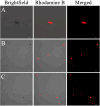Metal-Phenolic Network-Directed Coating of Lactobacillus plantarum: A Promising Strategy to Increase Stability
- PMID: 40647029
- PMCID: PMC12248584
- DOI: 10.3390/foods14132277
Metal-Phenolic Network-Directed Coating of Lactobacillus plantarum: A Promising Strategy to Increase Stability
Abstract
Lactobacillus plantarum exhibits probiotic effects, including regulating the balance of the intestinal microbiota and enhancing immune function. However, this strain often experiences viability loss upon ingestion due to harsh conditions within the human digestive tract. This study aimed to evaluate the efficacy of metal-phenol networks (MPNs) fabricated via three polyphenols-tannic acid (TA), tea polyphenol (TP), and anthocyanin (ACN)-combined with Fe(III) coatings in protecting Lactobacillus plantarum during simulated digestion and storage. The results demonstrated that MPNs formed a protective film on the bacterial surface. While TA and ACN inhibited the growth of Lactobacillus plantarum YJ7, TP stimulated proliferation. Within the MPNs system, only Fe(III)-TA exhibited growth-inhibitory effects. Notably, ACN displayed the highest proliferation rate during the initial 2 h, followed by TP between 3 and 4 h. All MPN-coated groups maintained high bacterial viability at 25 °C and -20 °C, with TP-coated bacteria showing the highest viable cell count, followed by TA and ACN. In vitro digestion experiments further revealed that the Fe(III)-ACN group exhibited the strongest resistance to artificial gastric juice. In conclusion, tea polyphenol and anthocyanin demonstrate superior potential for probiotic encapsulation, offering both protective stability during digestion and enhanced viability under storage conditions.
Keywords: Lactobacillus plantarum YJ7; metal–phenol networks; single-cell encapsulation; stability.
Conflict of interest statement
The authors declare no conflicts of interest.
Figures






References
-
- Colin H., Francisco G., Gregor R., Gibson G.G., Merenstein J.D., Bruno P., Lorenzo M., Berni C.R., Flint H.J., Seppo S., et al. Expert Consensus Document. The International Scientific Association for Probiotics and Prebiotics Consensus Statement on the Scope and Appropriate Use of the Term Probiotic. Nat. Rev. Gastroenterol. Hepatol. 2014;11:506–514. - PubMed
-
- Xu C., Fu Y., Liu F., Liu Z., Ma J., Jiang R., Song C., Jiang Z., Hou J. Purification and Antimicrobial Mechanism of a Novel Bacteriocin Produced by Lactobacillus rhamnosus 1.0320. LWT. 2020;137:110338. doi: 10.1016/j.lwt.2020.110338. - DOI
-
- Chong-Su K., Lina C., Minju S., Sungwoong J., Young C.W., Wook B.H., Dong-Mi S. Probiotic Supplementation Improves Cognitive Function and Mood with Changes in Gut Microbiota in Community-Dwelling Elderly: A Randomized, Double-Blind, Placebo-Controlled, Multicenter Trial. J. Gerontol. Ser. A Biol. Sci. Med. Sci. 2020;76:32–40. - PMC - PubMed
-
- Uma M.M., XinYee A., BoonKiat L., Fiona C.Y., Afiqah A.S.N., Abd H.I.J., Abu B.M.H., Syazni R.N., Xiaojun L., Xiaohong K., et al. Correction to: Probiotic Bifidobacterium Lactis Probio-M8 Treated and Prevented Acute RTI, Reduced Antibiotic Use and Hospital Stay in Hospitalized Young Children: A Randomized, Double-Blind, Placebo-Controlled Study. Eur. J. Nutr. 2022;61:1679–1691. - PMC - PubMed
Grants and funding
LinkOut - more resources
Full Text Sources

